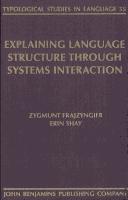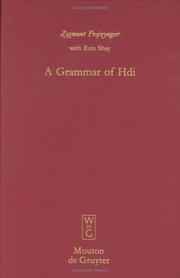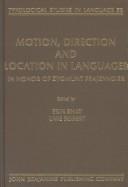| Listing 1 - 10 of 13 | << page >> |
Sort by
|
Book
ISBN: 9789004445901 Year: 2021 Publisher: Leiden : Brill,
Abstract | Keywords | Export | Availability | Bookmark
 Loading...
Loading...Choose an application
- Reference Manager
- EndNote
- RefWorks (Direct export to RefWorks)
"This is the first broad, detailed grammar of the Giziga language, which belongs to the Chadic branch of the Afro-Asiatic language family. The language is spoken in parts of the Far North Region of the Republic of Cameroon and can be divided into two dialects, Giziga and Northern Giziga, with about 80,000 native speakers in total. This volume describes the Giziga dialect, occasionally referring to the Northern variety, and aims to provide new information about this and other Afro-Asiatic languages for further research in linguistics, history, anthropology, sociology and related fields. The book will also be a tool helping Giziga speakers preserve their language, history and culture for future generations"--
Gisiga language --- Gisiga language --- Grammar. --- English.
Book
ISBN: 9004445978 9789004445970 9789004445901 Year: 2021 Publisher: Leiden Boston
Abstract | Keywords | Export | Availability | Bookmark
 Loading...
Loading...Choose an application
- Reference Manager
- EndNote
- RefWorks (Direct export to RefWorks)
"This is the first broad, detailed grammar of the Giziga language, which belongs to the Chadic branch of the Afro-Asiatic language family. The language is spoken in parts of the Far North Region of the Republic of Cameroon and can be divided into two dialects, Giziga and Northern Giziga, with about 80,000 native speakers in total. This volume describes the Giziga dialect, occasionally referring to the Northern variety, and aims to provide new information about this and other Afro-Asiatic languages for further research in linguistics, history, anthropology, sociology and related fields. The book will also be a tool helping Giziga speakers preserve their language, history and culture for future generations"--
Gisiga language --- Grammar. --- English.
Book
ISBN: 9780521865333 9781139423649 1139423649 1280773707 9781280773709 9781139419550 1139419552 0521865336 1139411217 1316089118 9786613684479 113942257X 1139417509 1139421603 1139020935 9781139020930 9781139411219 9781316089118 6613684473 9781139417501 9781139421607 1108977855 Year: 2012 Publisher: Cambridge Cambridge University Press
Abstract | Keywords | Export | Availability | Bookmark
 Loading...
Loading...Choose an application
- Reference Manager
- EndNote
- RefWorks (Direct export to RefWorks)
The first typological study of Afroasiatic languages. Afroasiatic languages are spoken by some 300 million people in Northern, Central and Eastern Africa and the Middle East. This book is the first typological study of these languages, which are comprised of around 375 living and extinct varieties. They are an important object of study because of their typological diversity in the areas of phonology (some have tone; others do not), morphology (some have extensive inflectional systems; others do not), position of the verb in the clause (some are verb-initial, some are verb-medial, and some are verb-final) and in the semantic functions they encode. This book documents this typological diversity and the typological similarities across the languages and includes information on endangered and little-known languages. Requiring no previous knowledge of the specific language families, it will be welcomed by linguists interested in linguistic theory, typology, historical linguistics and endangered languages, as well as scholars of Africa and the Middle East.
African languages --- Asian languages --- Afroasiatic languages. --- Langues chamito-sémitiques --- Langues chamito-sémitiques --- Language surveys. --- Language and languages --- Linguistic surveys --- Linguistic geography --- Surveys --- Afrasian languages --- Afro-Asiatic languages --- Erythraic languages --- Hamito-Semitic languages --- Semito-Hamitic languages
Book
ISBN: 9789027206923 9789027267283 9027267286 9027206929 Year: 2016 Volume: 111 Publisher: Amsterdam John Benjamins Publishing Company
Abstract | Keywords | Export | Availability | Bookmark
 Loading...
Loading...Choose an application
- Reference Manager
- EndNote
- RefWorks (Direct export to RefWorks)
Grammar --- Grammar, Comparative and general --- Functionalism (Linguistics) --- Typology (Linguistics) --- Linguistic models --- Syntax --- Syntaxe --- Modèles linguistiques --- Fonctionnalisme (linguistique) --- Typologie (linguistique) --- Syntaxe. --- Modèles linguistiques. --- Linguistic models. --- Language and languages --- Linguistic typology --- Linguistics --- Linguistic universals --- Functional analysis (Linguistics) --- Functional grammar --- Functional linguistics --- Functional-structural analysis (Linguistics) --- Grammar, Functional --- Grammatical functions --- Structural linguistics --- Models, Linguistic --- Syntax. --- Typology --- Classification --- Typologie linguistique. --- Grammar, Comparative and general - Syntax

ISBN: 9027229635 1588114368 9786612160486 1282160486 9027295565 9789027295569 Year: 2003 Volume: 55 Publisher: Amsterdam Benjamins
Abstract | Keywords | Export | Availability | Bookmark
 Loading...
Loading...Choose an application
- Reference Manager
- EndNote
- RefWorks (Direct export to RefWorks)
This book proposes a framework for describing languages through the description of relationships among lexicon, morphology, syntax, and phonology. The framework is based on the notion of formal coding means; the principle of functional transparency; the notion of functional domains; and the notion of systems interaction in the coding of functional domains. The study is based on original analyses of cross-linguistic data.The fundamental finding of the study is that different languages may code different functional domains, which must be discovered by analyzing the formal means available in each language. The first part of the book proposes a methodology for discovering functional domains and the second part describes the properties of various functional domains.The book presents new cross-linguistic analyses of theoretical issues including agreement; phenomena attributed to government; nominal classification; prerequisites for and implications of linear order coding; and defining characteristics of lexical categories.The study also contributes new analyses of specific problems in individual languages.
Grammar --- Grammaire comparée et générale --- Grammaire générale --- Grammaire générale et comparée --- Grammaire philosophique --- Grammaire universelle --- Grammar [Comparative and general ] --- Linguistics [Structural ] --- Linguistique structurale --- Linguïstiek [Structurele ] --- Spraakkunst [Vergelijkende en algemene ] --- Structural linguistics --- Structurele linguïstiek --- Structurele taalwetenschap --- Systeemtheorie --- System theory --- Systèmes [Théorie des ] --- Taalwetenschap [Structurele ] --- LANGUAGE ARTS & DISCIPLINES --- Linguistics / General --- Grammar, Comparative and general --- Philology & Linguistics --- Languages & Literatures --- Systems, Theory of --- Systems science --- Science --- Linguistics --- Comparative grammar --- Grammar, Philosophical --- Grammar, Universal --- Language and languages --- Philosophical grammar --- Philology --- Philosophy --- Grammar, Comparative --- Grammar, Comparative and general. --- Structural linguistics. --- System theory.
Book
ISBN: 9789027229878 9027229872 9786612105388 1282105388 9027290237 9789027290236 9781282105386 6612105380 Year: 2008 Volume: 75 Publisher: Amsterdam Benjamins
Abstract | Keywords | Export | Availability | Bookmark
 Loading...
Loading...Choose an application
- Reference Manager
- EndNote
- RefWorks (Direct export to RefWorks)
Afroasiatic languages --- Morphology. --- Syntax. --- African languages --- Asian languages --- Grammar --- Langues chamito-sémitiques --- Morphology --- Syntax --- Morphologie --- Syntaxe --- Afrasian languages --- Afro-Asiatic languages --- Erythraic languages --- Hamito-Semitic languages --- Semito-Hamitic languages
Book
ISBN: 9004410058 9004409157 Year: 2020 Publisher: Leiden, The Netherlands ; Boston : Brill,
Abstract | Keywords | Export | Availability | Bookmark
 Loading...
Loading...Choose an application
- Reference Manager
- EndNote
- RefWorks (Direct export to RefWorks)
A Grammar of Pévé is the first full description of the Pévé language, a member of the Chadic branch of the Afro-Asiatic language family. Pévé is spoken in parts of the southwestern area of the Republic of Chad and the Northern province of the Republic of Cameroon. The grammar will add to information and analyses concerning Afro-Asiatic languages and will help Pévé speakers preserve their language, history, cultural activities, and intercultural relations. The goal of the volume is to document and preserve the language for the benefit of generations to come and to make characteristics of the language available for further research in linguistics, history, anthropology, sociology and related fields.
Cameroon --- Languages. --- Pévé language --- Grammar. --- Ka'do Pévé language --- Lamé language (Chadic) --- Zime language (Pévé) --- Chadic languages --- PeÌveÌ language

ISBN: 311017071X Year: 2002 Publisher: Berlin Mouton de Gruyter
Abstract | Keywords | Export | Availability | Bookmark
 Loading...
Loading...Choose an application
- Reference Manager
- EndNote
- RefWorks (Direct export to RefWorks)
Book
Year: 2016 Publisher: Amsterdam, [Netherlands] ; Philadelphia, [Pennsylvania] : John Benjamins Publishing Company,
Abstract | Keywords | Export | Availability | Bookmark
 Loading...
Loading...Choose an application
- Reference Manager
- EndNote
- RefWorks (Direct export to RefWorks)
Grammar, Comparative and general --- Functionalism (Linguistics) --- Typology (Linguistics) --- Linguistic models. --- Syntax.

ISBN: 1283312050 9786613312051 9027275211 9789027275219 9781588114426 1588114422 9781283312059 9027229643 1588114422 9789027229649 Year: 2003 Publisher: Amsterdam Benjamins
Abstract | Keywords | Export | Availability | Bookmark
 Loading...
Loading...Choose an application
- Reference Manager
- EndNote
- RefWorks (Direct export to RefWorks)
This book contributes to an area of study that is of interest to linguists of all backgrounds. Typological in nature this volume presents data analysis from the major language families of Africa as well as Sino-Tibetan, Austronesian, Japanese, Indo-European, Siouan and Penutian. The 16 contributors to the volume share a commitment to examining the language phenomena pertaining to the volume's theme with a fresh eye. While most of the papers make reference to existing theoretical frameworks, each also makes a novel and sometimes surprising contribution to the body of knowledge and theory concer
Motion in language. --- Direction in language. --- Grammar, Comparative and general --- Locative constructions (Grammar) --- Linguistics --- Locative constructions. --- Case --- Syntax --- Direction in language --- Motion in language --- Locative constructions --- Grammar --- Grammar [Comparative and general ] --- Philology
| Listing 1 - 10 of 13 | << page >> |
Sort by
|

 Search
Search Feedback
Feedback About UniCat
About UniCat  Help
Help News
News